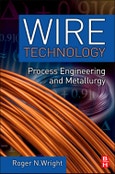Wire drawing is a metalworking process used to reduce the diameter of a wire by pulling the wire through a single, or series of, drawing die(s). The engineering applications of wire drawing are broad and far-reaching, including electrical wiring, cables, tension-loaded structural components, springs, paper clips and spokes for wheels.
This all-new, classical text is the first to explain the complex theory and sophisticated engineering concepts with relation to wire drawing in an accessible and universal way for practicing engineers.
Designed to facilitate the entry and training of new engineers and upgrade the professional practice of those already in the field in the face of increased product demands and tightening specifications, this essential resource by industry expert Roger Wright provides:
- A technical overview and introduction of engineering concepts related to wire drawing, suitable for beginners and practiced engineers looking to brush up on the theory behind the process
- An interface with basic engineering education so as to provide an accessible introduction for engineers new to the field
- Real-world worked examples, problems and protocols based on true life engineering scenarios and challenges
- Unique coverage of the author's own pass design and risk prediction calculations, developed through decades of research and wire industry consulting
Whilst most competing titles are less practical in their approach and focus on either ferrous, non-ferrous or electrical, our book takes a universal approach more suited to the practicing engineer who needs knowledge of wire drawing across the board. Ideal for use as a complete insight into the process from start to finish or a dip-in resource for practical problem-solving, this versatile work-a-day guide, training tool and desk reference will help readers train their staff and adapt and improve processes at minimal cost for maximum performance.
Please Note: This is an On Demand product, delivery may take up to 11 working days after payment has been received.
Table of Contents
PrefaceChapter 1 The General Idea
Chapter 2 A brief history of the technology
Chapter 3 Twentieth century equipment concepts
Chapter 4 Basic engineering variables pertinent to drawing
Chapter 5 Basic drawing mechanics
Chapter 6 Drawing temperature
Chapter 7 Drawing speed
Chapter 8 Friction, lubrication and surface quality
Chapter 9 Drawing die and pass schedule design
Chapter 10 Shaped dies and roller dies
Chapter 11 Mechanical properties of wire and related testing
Chapter 12 Drawability and breaks
Chapter 13 Copper and copper alloy metallurgical issues
Chapter 14 Steel metallurgical issues
Chapter 15 Issues in other important metallurgical systems
Chapter 16 Wire coatings
Chapter 17 Redraw rod production
Chapter 18 Physical Properties
Chapter 19 Elements of wire forming
Chapter 20 Some illustrative new products and processes
List of symbols English alphabet
List of symbols Greek alphabet
Appendix of basic formulas
Index
Authors
Roger N. Wright Leading wire industry trainer and consultant, and Professor Emeritus, School of Engineering, Rensselaer Polytechnic Institute, Troy, NY, USA. Roger N. Wright, Professor Emeritus, School of Engineering, Rensselaer Polytechnic Institute, has contributed broadly to the literature in the areas of metallurgy and metals processing, and is active as a short-course lecturer and consultant. Prior to joining Rensselaer, he was a senior staff member at Westinghouse Research Laboratories and at Allegheny Ludlum Steel Corporation. He holds B.S. and Sc.D. degrees in metallurgy from Massachusetts Institute of Technology. He is aregistered professional engineer and a fellow of ASM International and of the Society of Manufacturing Engineers.








